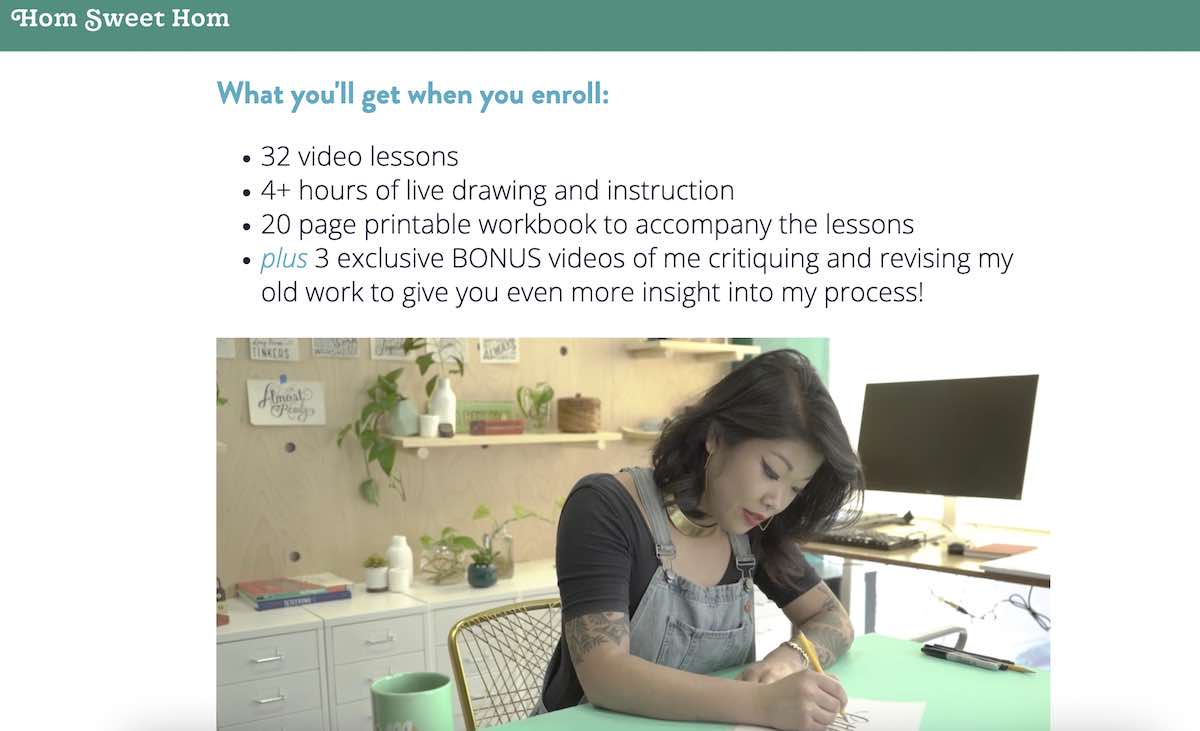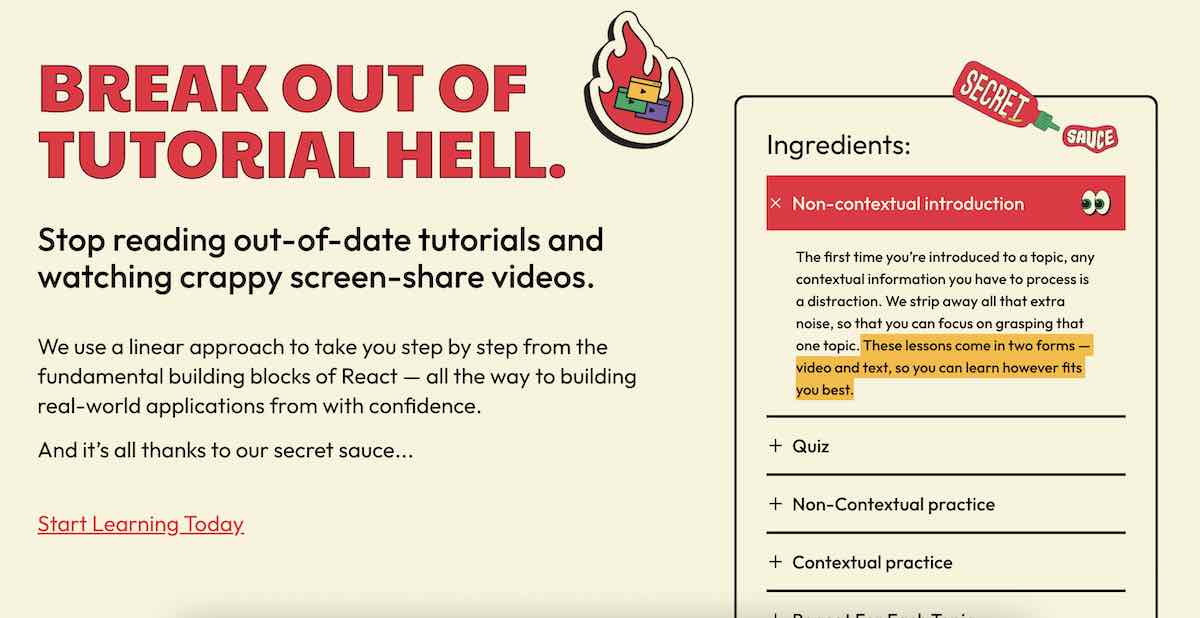We all absorb and retain information in different ways. Some people learn faster and more efficiently when content includes visuals like charts, photos, or videos. Others prefer to read and write to retain information. Course creators that know the different types of learning styles can use them to improve student experiences and outcomes. If you know your students and the ways they learn, you can adapt your teaching styles to suit them better.
Creating courses with learning and teaching styles in mind will set you and your students up for success. We’ll go over each learning method and how to identify them. Plus, we’ll provide examples and tips on how to create courses, coaching, and other educational products for each learning style.
What are learning styles?
Learning styles are the methods that people use to understand and remember information. By identifying your students’ learning styles, you can create course materials that suit their preferences.
There is some debate over how many types of learning exist. Most agree that there are four to seven learning styles. We’ll go over each in detail below.
It’s also important to note that one person can have multiple styles. These are known as multimodal learners. They retain information and may thrive using more than one learning style.
The seven types of learning
New Zealand educator Neil Fleming developed the VARK model in 1987. It’s one of the most common methods to identify learning styles. Fleming proposed four primary learning preferences—visual, auditory, reading/writing, and kinesthetic. The first letter of each spells out the acronym (VARK).
We’ll go over the VARK learning styles and three others that researchers and educators have identified below.
1. Visual learning
When you create a course curriculum, consider how many and what type of visuals to include. A 2019 study claims that around 65% of people are visual learners. In other words, visual learners make up the majority of the population. You’ll likely have several in your courses, so keep that in mind when creating materials for it.
To learn best, visual learners need graphs, illustrations, diagrams, videos, and other visuals. You can also teach visual learners better by incorporating these into your lessons.
- Images
- Charts
- Maps
- Infographics
- Illustrations
- Photographs
- Flashcards with images
- Animations
- Virtual whiteboards
Using all of these visuals at once will overwhelm your students. Instead, identify opportunities to display information as a visual and choose the best method for it.
Video courses are the best way to help visual learners. If you’re new to recording videos, you can take a course or watch a tutorial on making high-quality videos for your courses. You can also design and voiceover slideshows.
Visual learners also read and write like other students but may add images to notes, highlight sentences, or draw graphs. It can be helpful to provide them with downloadable versions of course materials so that they can take notes. If you use Teachable, you can easily add digital downloads to your website and courses.
Teachable creator Lauren Hom’s lettering course combines visual and other types of learning styles. Course lessons include videos, live drawing practice, and printable workbooks.

2. Auditory learning
In the same study, researchers found that around 30% of people are auditory learners. Auditory learners like to listen to absorb information. Auditory learners may listen to lectures, podcasts, music, and videos.
They also tend to read their notes aloud to help them understand and retain information or listen to music to study.
You can cater to auditory learners by:
- Using music and songs to remember information
- Providing audio versions of notes
- Encouraging discussions of learning materials
In addition to adjusting your teaching methods to different types of learners, you should also consider the subject.
For example, if you teach guitar online, it will naturally have an audio element. However, you may combine the sounds of different guitar strings with images and videos of them. When you combine different teaching methods, you can cater to multiple learning styles.
3. Reading and writing
Learners who prefer reading and writing thrive with traditional textbooks, handouts, and written assignments. Reading and writing learners are similar to visual learners because they like to see the information on a page.
To teach reading and writing learners, try to present information in one of these forms:
- Books
- Articles
- Blogs
- Essays
- Written instructions
- Workbooks
- Quizzes
- Written assignments
You could also consider creating an ebook to supplement your course material. So if you have a video course, add transcripts to your lessons so students can read along and take notes.
{{digitaldownload-component="/blog-shortcodes/blog-popup"}}
4. Kinesthetic
The kinesthetic learning style is learning by doing. And people who are kinesthetic learners learn better when they’re physically moving and getting hands-on experience.
Kinesthetic learners prefer playing games or doing puzzles as part of the learning process. They tend to enjoy problem-solving and trying new activities to build skills.
Many people associate kinesthetic learning with physical activities and in-person learning environments. However, you can still cater to kinesthetic learners when you create an online course.
For example, many developer courses include coding challenges, hackathons, and other activities where students learn by doing.
Here are some ideas to help you teach kinesthetic learners:
- Schedule short breaks for live courses longer than 30 minutes.
- Add real-life assignments. For example, a course about plants may add a practical element where students transplant and care for a houseplant.
- Create project briefs based on real-life scenarios, so students can practice.
- Add physical activity. Some online courses—meditation, yoga, and fitness—will naturally be more interactive.
If you want to add a more physical element, you can also include printables and supplies. Another option is to send materials to students in the mail.
There are many ways to teach kinesthetic learners. One example is the Hands-on Kids Activities Club (HOKA), a membership club for teachers. Every month, teachers get downloadable printables and other resources to create hands-on learning experiences. In one bundle, students learn about an artist and do an art project in that artist’s style.

5. Verbal or linguistic learning
Verbal learners or linguistic learners retain information best by hearing and envisioning words. You may also hear this called verbal-linguistic learning. Similar to an auditory learner, a verbal learner speaks aloud to memorize information better. They tend to be avid readers and may be talented storytellers or poets.
Any of these can help a verbal learner:
- Lectures
- Podcasts
- Presentations
- Flashcards with words
- Word games and puzzles
This type of learning is also common in language courses. If you teach students how to speak Spanish, English, French, or another language, verbal learning will come in handy. They’ll want to hear how you pronounce words and practice speaking them on their own.
6. Social or interpersonal learning
Some students learn better alone and others learn better while in groups. Social, also called interpersonal, learners thrive in group discussions and group coaching.
They enjoy speaking in front of groups and asking questions. A social learner will like to give and receive feedback from other students and bounce ideas off others.
Interpersonal learners prefer these types of activities:
- Group discussions and activities
- Public speaking—presenting their work
- Working with a partner
- Studying flashcards with a partner
- Team-building exercises
7. Solitary or intrapersonal learning
Solitary learners prefer to learn on their own rather than with groups of peers. The word intrapersonal is similar to introvert—they can feel drained from social activities.
These students don’t enjoy group work and would rather get a list of items to study and work independently. Instead of getting ideas and feedback from other students, solitary learners are more introspective. They can get lost in their work and are more hesitant to ask for feedback or ideas from others.
Here are some ideas to help teach solitary learners:
- Ask questions to build trust and learn more about them.
- Give them space to work independently.
- Explain the why behind projects. Solitary learners focus on the future and outcomes, so they like to know the importance of learning different concepts.
Solitary learners are self-starters, so they usually have the determination to complete a course. Even though they prefer learning independently, learning from others has many benefits too.
Sometimes getting a solitary learner to open up more, ask for feedback, and challenge themselves can improve their learning. You could also offer solitary learners coaching or feedback sessions with you to help them develop their learning in a one-on-one environment.
How to identify student learning styles
Most adults have a sense of their preferred learning style. You can ask students or coaching clients which methods they prefer via an intake form when they sign up for your courses or coaching.
To identify learning styles, you can:
- Include an intake form on your sign-up pages
- Ask new students about their preferred learning styles directly
- Observe your students throughout the course
- Use assessments to help students figure out the learning style they like best
You can also use an online quiz like the VARK questionnaire to understand new students better. Another option is to create your own assessment and tailor it to your teaching style and course topic. Some sample questions you can use to create a quiz or questionnaire to identify learning styles are:
- Do you prefer to work alone or in groups?
- Would diagrams and illustrations make it easier to understand a concept?
- Is it easier to remember something in words or images?
- To understand how a machine works, would you take the machine apart yourself?
- Do you remember facts and figures more by hearing them spoken or reading them?
Let students know this is the kind of quiz with no wrong answer. You’ll use the answers to understand what type of learning style they prefer and tailor your teaching to better suit them.
Note that this type of questionnaire works best with coaching or online courses that use cohorts with specific start dates. You can use it to fine-tune your course curriculum for each cohort or personalize coaching sessions.
{{audience-component="/blog-shortcodes/blog-popup"}}
How to teach different types of learning
As you plan your course, think about how you can accommodate each learning style. For example, auditory learners usually thrive on discussion. On the other hand, learners who prefer to read and write might struggle with group discussions or debates. Discussions can be harder for them because they like to write their thoughts down first before speaking.
To accommodate different types of learning styles, provide several options. In the example above, you could give your students a discussion prompt ahead of time. Reading and writing learners can write talking points down before and auditory learners get the benefits of learning through discussion.
The ui.dev online courses are perfect examples of how to consider different types of learning. Looking at their React coding course, you can see that they provide lessons in two forms—video and text. This way visual, auditory, and reading and writing learners can refer to the materials that they understand best. It also includes kinesthetic learning with practice coding activities and projects where students build real-world applications.

Share your knowledge online
No two students are exactly alike—a learning style that works for some students might not work for others. You can still offer your students or clients a meaningful learning experience.
Identifying how your students learn best helps you teach them in ways that will be the most successful. It also shows them that you care about their learning experience and outcomes. So by considering all the different learning styles, you’ll create an online course that appeals to a larger pool of people.
If you’re ready to share your knowledge with all types of learning styles, you can easily create a course on Teachable. And then you can create online courses, coaching services, and even digital downloads. To get started, sign up for free or choose from one of the paid plans.
Join more than 150,000 creators who use Teachable to make a real impact and earn a real income.



.png)





